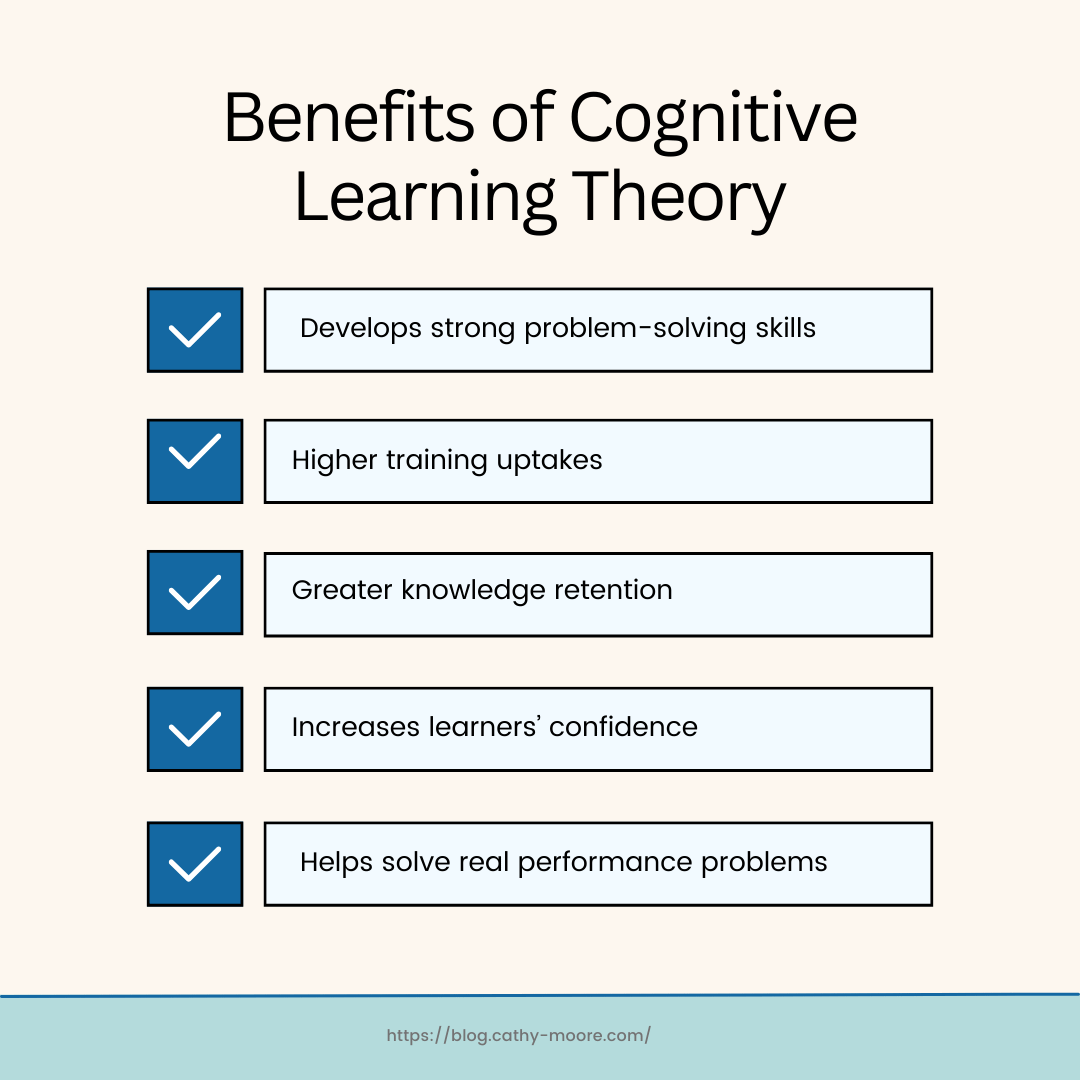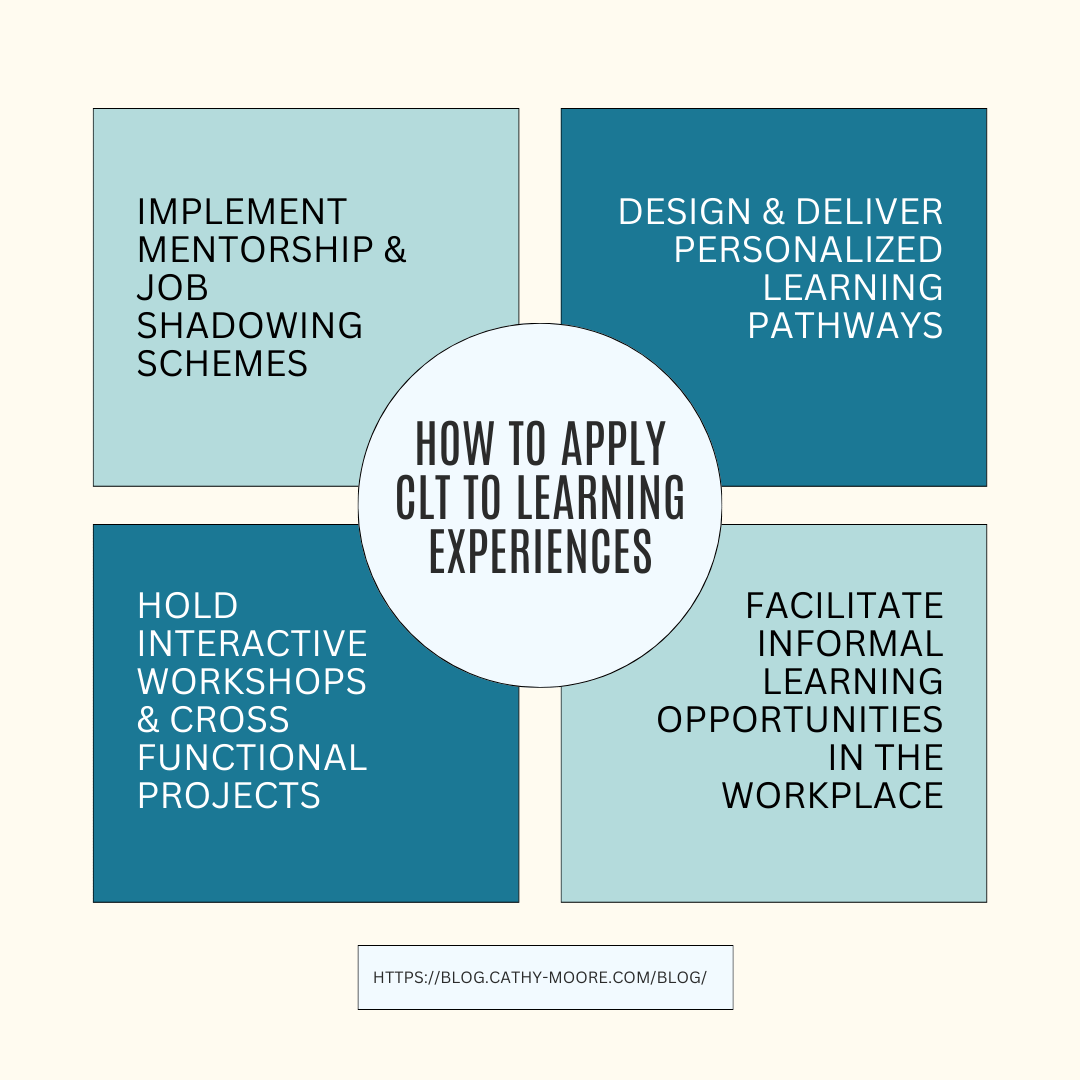Cognitive learning theory (CLT) recognizes that there are different ways of learning, and the more we experiment with this, the better we master the subject at hand. In fact, it’s a valuable theory that may come in handy in fully understanding employee education.
In this post, you’ll discover:
- What is Cognitive Learning Theory (CLT)?
- The three most popular CLT theories
- Benefits of CLT in workplace learning
- How to apply cognitive learning theory to corporate training (it’s easy!)
What is CLT? A no-nonsense definition
Think back to your school days. If you were anything like me, you spent the night before exams cramming as much information as possible. It was all about note-taking, repetition, and memorizing.
While that may work in the short term, how much of that information can you actually recall and use today? Probably not that much.
That’s because learning through repetition really only helps you with the immediate goal of acing an exam. As an adult learner, your goal is likely deeper than that. You actually want to learn new information so you can apply it to your job and become an expert.
So, you need a different learning approach.
Cognitive Learning Theory studies how humans learn through information processing. It focuses on what happens in our brains as we receive, process, and store new information.
Why, you may ask? Because CLT asserts that to properly understand learners’ behaviors, we must first understand the cognitive processes that happen in the brain during learning.
According to CLT, learning is an active process. During this process, learners interpret knowledge based on their past experiences.
Rather than simply seeing information and storing it, the learner’s mind goes through several cognitive processes, including perception, problem-solving, and memory.
CLT studies what processes take place as learners absorb, interpret, store, and recall information.
These cognitive processes can be broken down into three categories:
- Comprehension – Learners understand why they’re training on this topic.
- Memory – Learners relate newly acquired information to past experiences to gain a deeper understanding (past simple memorization).
- Application – Learners take the new knowledge and use it in their jobs.
Now that you’ve got the nuts and bolts, we’re going to take a closer look at the three most popular CLT theories.
The big three: popular cognitive learning theories
Since the term was first coined, more cognitive learning theories have gained traction. In particular, there are two popular branches of CLT that you should know about.
Let’s start with the main one:
1. Cognitive Learning Theory (the original)
The term cognitive learning theory was first introduced in 1936 by Jean Piaget, an educational psychologist.
Piaget believed that learners actively construct knowledge in their minds during learning and that they build upon previous knowledge and experiences.
Essentially, these cognitive processes influence how an individual learner organizes, interprets, and categorizes new information.
That means that two learners can study the same material under the same conditions and have totally different experiences and outcomes.
Since its inception, many prominent psychologists have contributed to CLT and its application.
One notable contributor is the American psychologist Jerome Bruner. Bruner focused his work on the link between teaching and mental processes.
He highlighted the role of culture and language in cognitive development and believed the goal of education should be creating autonomous learners.
This is the original theory. Now let’s look at two other branches.
2. Social Cognitive Theory (SCT)
The second branch of CLT explores the four main components of the learning process. These are:
- Observation (external)
- Retention (internal)
- Reproduction (internal)
- Motivation (external and internal)
Let’s say you’re in a meeting, and senior management is discussing how to handle a problem.
You might sit back and listen to what they’re saying (observing) and retain key pieces of the conversation. What those key pieces are depends on your individual internal cognitive processes.
Now imagine this problem coming up again in the future. You are likely to recall this information and use it to solve the issue.
In short, social cognitive theory looks at how social interactions and the environment influence learning outcomes.
Here are three SCL concepts you should know:
- Reciprocal determinism – The learner, their behavior, and their environment all interact and impact learning outcomes.
- Positive and negative reinforcement – How others respond to behaviors affects a learner’s behavior.
- Observational learning – Learners can watch a peer perform an action and then repeat the action.
As instructional designers, this is gold.
We can apply the principles of social cognitive theory to our learning experience design to create higher engagement and better training outcomes.
3. Cognitive Behavioral Theory (CBT)
Cognitive behavioral theory investigates the role of cognition in learners’ behaviors. It looks at how your thoughts affect your behavior patterns and the influence of your self-concepts on the learning process. These self-concepts are shaped by a variety of internal and external factors and can be both positive and negative.
The Cognitive Triad is a major part of this theory. It explores how negative thoughts impact human behavior, considering three main elements: the self, the world, and the future.
In other words, it shows the link between mindset and how we learn.
This is very useful in employee training because it suggests that, in order to garner effective training outcomes, you must first motivate learners and encourage them to develop a growth mindset.
Research supports this, revealing that highly motivated learners achieve better learning outcomes and enhanced knowledge retention.
Next up: The benefits of cognitive learning theory for your learners (and your business).
Main benefits of CLT for learners
Cognitive learning approaches are more than “nice to know.” They can actually bring hugely positive results for your learners and your business performance.
From improved knowledge retention to more autonomous employees, here are the main advantages you can expect:
- Development of strong problem-solving skills
- Enhancement of learning experiences, leading to higher training uptake
- Promotion of greater understanding of the training topic and a boost in knowledge retention
- Increase in learners’ confidence, contributing to a culture of continuous learning
- Creation of more learner-centric training that helps solve real performance problems

Now that the theory is out of the way, let’s explore some simple ways to apply cognitive learning to your current L&D strategy.
How to apply CLT to learning experiences
Here’s the fun part. We’ve compiled some great strategies on how to apply CLT to your corporate learning experiences.

1. Implement mentorship and job shadowing schemes
Create opportunities for employees to learn from each other.
For example, initiatives such as mentorship programs and job shadowing enable staff to observe others and learn from them.
This type of workplace training creates space for meaningful, experiential learning and implicit (or accidental) learning.
Your employees get to actively participate in the learning process, building on their existing knowledge. Plus, they’re learning relevant skills that they can apply right away.
2. Design personalized learning paths
If we’ve learned anything in this guide, it’s that learners are all different. Their life experiences, cognitive processes, and environment all impact how they receive and interpret training.
As L&D professionals, we can adapt to this by offering personalized learning tracks.
For instance, allowing learners to decide how they move through training courses based on their experience, job role, or learning preferences.
This works best with eLearning because it offers a flexible, on-demand training option for employees. That way, they can study in the environment that is best for them.
Taking a learner-centric approach ensures every employee can actively participate in training initiatives and see the relevance of the training for their job role.
3. Hold interactive workshops
Another way to leverage the benefits of CLT is to create opportunities for employees to participate in hands-on, experiential training.
For example, holding workshops or group projects that encourage staff to work together to solve a problem. That way, everyone can learn from each other and participate in the process.
Facilitators can offer advice and feedback throughout the process, encouraging learners to cultivate a growth mindset.
4. Encourage learning to continue outside of formal classroom situations
If you’re familiar with the 70:20:10 L&D model, you’ll know that only 10% of workplace learning takes place during formal training events.
In contrast, 70% of learning comes from on-the-job experiences and 20% from interactions with our peers.
This tells us that we need to create more opportunities for informal learning in our organizations.
Here are some examples of how to achieve this:
- Implement peer-to-peer learning schemes. Have in-house SMEs host workshops to share their expertise in a certain area or tool. Alternatively, create job swap programs or other cross-functional teams to facilitate peer-to-peer learning.
- Use your learning management system (LMS) to encourage social learning and knowledge sharing. For example, set up discussion forums, study channels, and spaces for colleagues to share interesting learning materials (podcasts, articles, ‘How to’ guides, etc.). Don’t have an LMS? Use Slack or your internal intranet.
- Include interactive activities in your training sessions. This could include real-world examples, scenario-based training activities, and interactive quizzes. Basically, anything that encourages learners to actively participate in the learning process. Here are some ideas on how to involve learners.
- Avoid “one size fits all” and off-the-shelf learning. Sure, these have their place in your L&D strategy. But if you really want your training to elicit a behavior change or solve a performance issue, you need to personalize it for your learners and organization.
Final thoughts
Cognitive learning theory gives us valuable insights into how adult learners receive and interpret new information. As L&D professionals, this better positions us to create more effective learning experiences that meet learners’ needs. It also highlights the importance of environment and mindset in the learning process.
We hope these tips have given you some inspiration. Do you have any tips on how to incorporate CLT into online learning experiences? Share your thoughts below.

By Nicola Wylie
Nicola Wylie is a learning industry expert who loves sharing in-depth insights into the latest trends, challenges, and technologies.
